Types and planting of fescue for the lawn
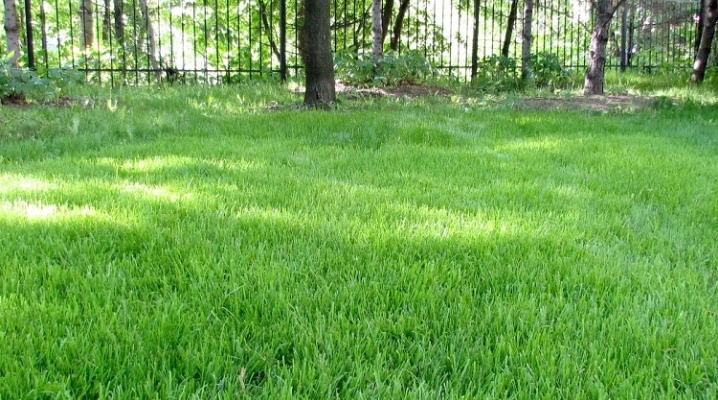
Fescue is a perennial cereal crop, reaching a height of 60 cm. In its natural environment, it grows in meadows, and in dachas and in private farms it is widespread as a decoration for sowing and roll lawns. Differs in unpretentiousness to the type of soil and climate: the plant withstands drought and frost, grows well and develops even on poor soil.
Pros and cons of using
Fescue is a perennial herbaceous crop. The root system is creeping, shortened. The aerial part is stem, erect, slightly leafy. The leaf plates are flat, rough at the edges and on top. The foliage is narrow-linear, 3-5 mm wide, there are small ears at the base.
Summer bloom. The size of the panicle varies between 7-20 cm. The panicle itself can be compressed or spreading... Spikelets have a light purple hue, the shape is elongated, oblong. The spikelet length is 1.5-2 cm. The plant is popular when arranging lawns. In addition, it is of exceptional forage value and has the ability to resist mowing and grazing. High demands are placed on lawn crops.
Fescue has undeniable advantages over many other plants, thanks to which it has become widespread in gardening.
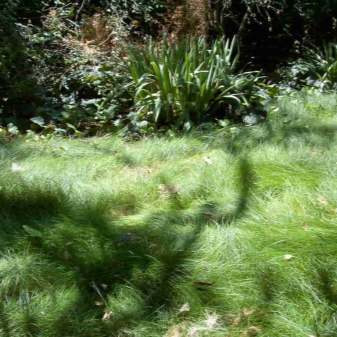
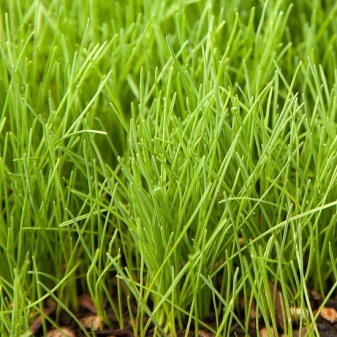
Consider these pros:
- creating a fluffy and solid carpet base;
- fast germination: seeds emerge after 5-7 days, and a month later an even grassy cover is formed;
- the plant is suitable for forming a lawn cover between the rest of the garden plantings;
- fescue is characterized by high resistance to drought, grows well in sun-drenched areas, tolerates up to 14 days without watering and rain.
Fescue, subject to all agricultural technologies, retains its original appearance for 10-15 years. Even an old lawn looks attractive. In addition, fescue is an extremely unpretentious crop: it can develop successfully even on poor, marginal soils and on sandy soil. However, it should be borne in mind that this herb does not tolerate trampling, so you should not plant it for arranging children's and sports grounds. With active use, bald spots are formed, and they significantly impair the appearance of the grass carpet.
Conditional disadvantages include invasiveness culture. It can reproduce not only by seeds, therefore it will actively develop unoccupied areas through the spread of rhizomes.
And if the grass is not regularly mowed, then the structure of the rhizomes will become so dense that it will impede the growth of any other plants.

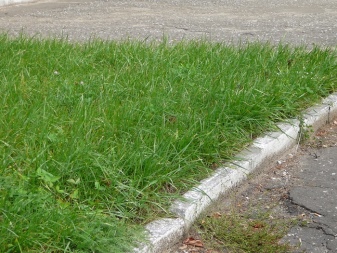
Description of species
There are several types of fescue, let's take a closer look at them.
- Red. The peculiarity of this species is that it spreads through the territory through underground shoots. Thanks to this, the grass is widely used for patching bald patches on lawns. It grows and develops best on light soils in cool climates.
- Red haired. It has thin elongated leaves. Differs in the greatest endurance when compared with other species. Quite tolerant of the lack of sun, used for shady lawns. Popular for golf courses and decorative lawns.
- Red is tough. Grows in dense, low-growing bushes, forming a dense herbage.Well tolerates lack of watering and prolonged heat. It is used in all types of lawns, except for sports.
- Reed. It is a drought and heat resistant variety. This property is explained by the peculiarities of the root system, which can penetrate deep into the ground and receive moisture even when the top layer dries out. On hot days, in the absence of irrigation, reed fescue retains its rich color and decorative appearance. Withstands trampling, therefore it is used for arranging playgrounds and sports lawns.
- Sheep. One of the most unpretentious varieties, it thrives on poor soils, tolerates drought and winter frosts. Can grow in shade, forms a dense herbage. It is used to decorate lawns on personal plots, all kinds of embankments and roadsides.
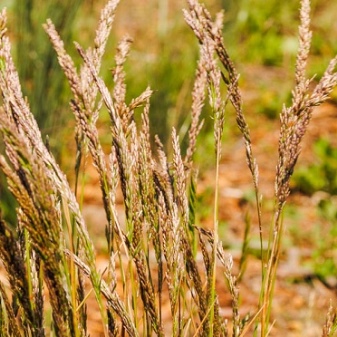

How to sow a lawn?
For the cultivation of lawn coverings in central Russia, grass mixtures based on fescue and bluegrass are used. The combination of these herbs forms a dense grass cover that is durable and resistant to cold weather. To get high quality coverage, you need to follow simple rules.
Seed selection
Poor seed quality is the main reason for unsightly lawns. Each package must have a tag indicating the names of the herbs that make up the mixture, their ratio, purpose, percentage of germination, as well as the speed of germination. It is also advisable to see information on the percentage of germination of weeds through sown crops. However, domestic seed suppliers rarely indicate this parameter.
It is recommended to purchase a mixture consisting of two or three crops, one of which is fescue, and other herbs should be similar to it in terms of agricultural technology. The label should indicate the purpose of the grass mixture - "for the lawn". Large companies usually sell seeds that have been pretreated with fungicides and growth promoters. These measures improve the germination of seedlings, prevent the development of fungal diseases.
Russian producers often combine fescue and meadow bluegrass. These herbs grow at the same rate, but react differently to sun and moisture levels. Thus, if one of the crops is negatively affected by the environment, the second plant does not respond to these problems, and the lawn still remains green.
Both crops usually have the same height and stem thickness, so the lawn looks aesthetically pleasing.
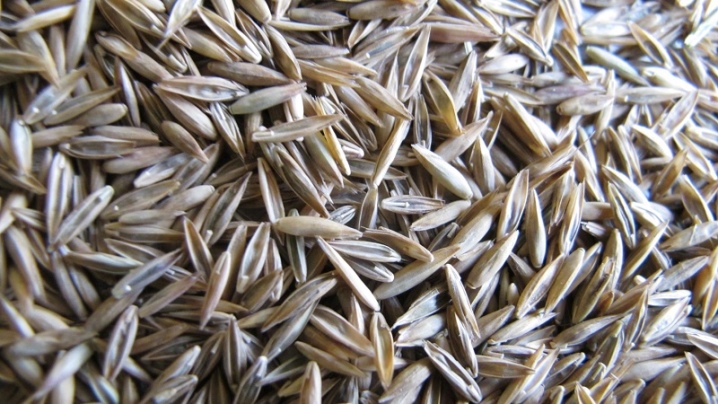
Timing
In the natural environment, the seeds fall off after ripening. They hibernate in the soil, and germinate after the snow melts. Therefore, you can plant fescue in both spring and autumn. The only time not recommended for sowing is summer. During this period, the sun's rays evaporate too much moisture and the grass has to fight hard to survive. Therefore, it is optimal to plant a lawn in a season when the soil contains a lot of water, and the night air temperature is kept at around 12-15 degrees.
If you have to plant a lawn in the summer, then try not to allow the soil to dry out.... You will definitely need to install an autowatering system.

Landing technology
In the area set aside for growing lawn grass, it is necessary to destroy all weeds, uproot stumps, remove stones and other debris. To do this, you can use manual removal, mulching or deep cultivation. The preliminary cultivation of green manures or the treatment of the land with herbicides have a good effect. The land for the lawn is plowed to the depth of the shovel bayonet.
In the course of plowing, all large earthy clods should be broken - this will make the substrate as fertile and loose as possible. After digging, the surface should be leveled with a rake, removing all the bumps, leveling the holes.
For the full growth and development of the grass mixture, soil with a neutral pH level is suitable. If the soil has an alkaline reaction, add a little peat crumb; to neutralize acidity, the soil is subjected to liming. To increase fertility, organic fertilizers are introduced into the soil: vermicompost, rotted manure or compost. If necessary, you can completely renew the top layer of the earth, replacing it with fertile turf. After carrying out all the preparatory work for the cultivation of the territory, the land is carefully leveled and rolled with a roller.
On the rammed surface, smooth longitudinal and transverse grooves with a depth of 1-1.5 cm are formed. Seeds are sown at the rate of 40-60 g / m2. The exact seeding rates are usually indicated on the package with the grass mixture. At the final stage, the seeds are sealed and the soil is re-rolled with a roller or a heavy round pipe. Before the emergence of seedlings, irrigation is carried out by the drip method.
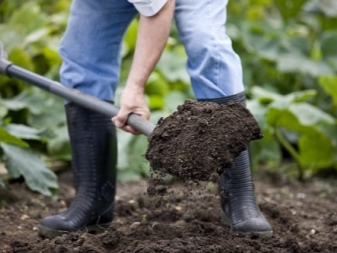
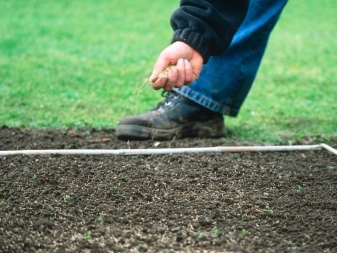
Care Tips
Fescue is generally quite unpretentious. However, the lawn will look more decorative if properly cared for. Water the lawn grass as the soil dries up. If the grass is planted for decorative purposes, then use automatic watering, while it is better to water the sites for active pastime at night.
Remove dried grass and weeds regularly. They prevent air and nutrients from reaching the roots, thereby blocking the growth of fescue. Keep in mind that in the early years there are many weeds: they grow from seeds that were originally in the ground or were transferred by birds. In places with excess moisture, the appearance of moss is not excluded. In this case, the drainage of the area should be improved.
Plants require aeration to keep soil bacteria alive. To do this, every 10-14 days you need to pierce the ground with a garden fork. These measures will allow air to penetrate into the deepest layers of the soil.
From time to time, the lawn needs to be mowed or mowed. Work can be done at any time, but it is important that the grass is dry. Otherwise, the risk of phytopathogenic microflora appearance increases. In places where, for some reason, bald spots have appeared, sowing must be performed.
Fescue needs fertilization two to three times a year. In spring, the crop responds well to nitrogen fertilizers, in autumn - to phosphorus-potassium mixtures. A good effect is the use of potassium sulfate and ammonium nitrate: they are applied at the rate of 10 g / m2.
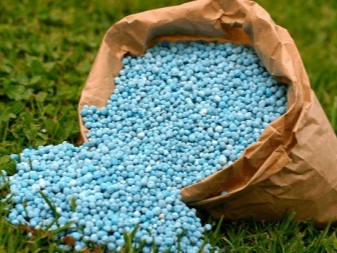

Review overview
Gardeners often use fescue to form lawns. However, they note that the herb can only be used as part of a seed mixture... In this case, the percentage of fescue should differ depending on the operating conditions. So, when making a decorative lawn, the volume of culture may prevail. Fescue copes well with the task of decorating the borders and zoning the site. And here for sowing a sports lawn or a playground, its share should be minimal.
Fescue lawn does not deteriorate from mowing, and the stems do not get thick. This determines the high attractiveness of culture for the arrangement of adjacent territories.
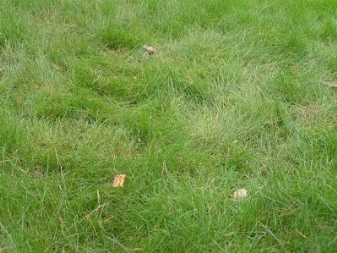

For information on how to properly care for your lawn, see the next video.



































































The comment was sent successfully.